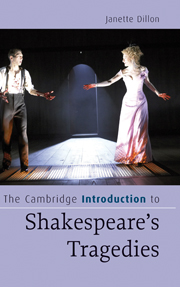Book contents
- Frontmatter
- Contents
- Acknowledgements
- Introduction
- Chapter 1 Tragedy before Shakespeare
- Chapter 2 Titus Andronicus
- Chapter 3 Romeo and Juliet
- Chapter 4 Julius Caesar
- Chapter 5 Hamlet
- Chapter 6 Othello
- Chapter 7 Timon of Athens
- Chapter 8 King Lear
- Chapter 9 Macbeth
- Chapter 10 Antony and Cleopatra
- Chapter 11 Coriolanus
- Notes
- Index
Introduction
Published online by Cambridge University Press: 05 August 2015
- Frontmatter
- Contents
- Acknowledgements
- Introduction
- Chapter 1 Tragedy before Shakespeare
- Chapter 2 Titus Andronicus
- Chapter 3 Romeo and Juliet
- Chapter 4 Julius Caesar
- Chapter 5 Hamlet
- Chapter 6 Othello
- Chapter 7 Timon of Athens
- Chapter 8 King Lear
- Chapter 9 Macbeth
- Chapter 10 Antony and Cleopatra
- Chapter 11 Coriolanus
- Notes
- Index
Summary
Imagine that, as in the current vogue of Saturday night British television, you are watching the Top 100 Shakespearean Tragic Moments. What will reach the top five? Macbeth clutching at an imaginary dagger? Lear with Cordelia in his arms? Cleopatra holding the asp to her breast? Juliet falling on Romeo's body? Number one would surely have to be one of two iconic moments from Hamlet: ‘Alas, poor Yorick’ or ‘To be or not to be’. Do these moments have anything in common that helps us towards a definition of Shakespearean tragedy? The only more or less common factor is perhaps a relentless focus on the solitary individual; but this may be less an effect of Shakespearean tragedy itself than of a post-Romantic way of reading Shakespearean tragedy almost solely through the lens of the tragic hero. Of course Shakespearean tragedies do have heroes, some more heroic than others, and one or two very hard indeed either to admire or to sympathise with (Coriolanus or Timon, for example). These moments, however, are less individually focused than they may appear to be at first glance. Lear and Juliet are both embracing a lost loved one and Lear is surrounded by other people in that moment; Cleopatra has to struggle to get rid of the clown before she can put the asp to her breast, and Charmian remains at her side for the moment itself; Hamlet is with Horatio and has been exchanging jokes with the gravedigger when the gravedigger throws up Yorick's skull; Hamlet is observed by Claudius, Polonius and Ophelia when he ponders whether to live or die. Only Macbeth is alone when he reaches for the dagger.
Neither Shakespearean tragedy nor earlier Elizabethan tragedy would usually emphasise the individual to the exclusion of the state. Indeed a feature shared by all Shakespeare's tragedies, as well as by most of the tragedies written by Shakespeare's contemporaries, is that their closure depends on a restoration of political order following the central death or deaths of individuals.
- Type
- Chapter
- Information
- Publisher: Cambridge University PressPrint publication year: 2007

